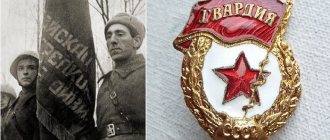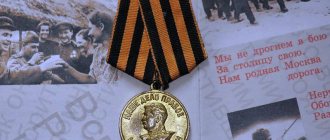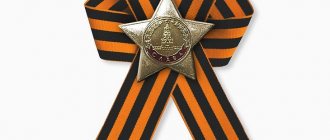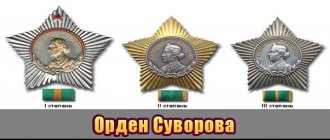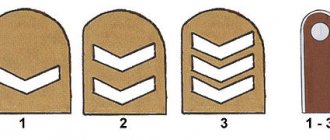The Guards Ribbon is a glorious successor to the traditions of the St. George Ribbon, although its appearance in the USSR is not formally connected with the award of Tsarist Russia. This award, as well as the return of officer ranks in the Red Army, are associated precisely with the revival of Russia’s patriotic past, so it would be incorrect to consider the Guards Ribbon separately from the St. George’s Ribbon. Now many people tie a guards ribbon on their clothes to celebrate Victory Day, but few people know the real history of this award and why it became a symbol of Victory Day in the Second World War.
The history of the appearance of the guards ribbon
The USSR Guards Ribbon was introduced after the emergence of the so-called “Soviet Guard,” which appeared in 1941 after the Battle of Yelnya. Four motorized rifle infantry divisions were awarded the title of “Guards Divisions,” and in 1942 the Guards breastplate appeared. Later, this ribbon was used to decorate the last for the Order of Glory and the medal “For Victory over Germany.”
Although the appearance of the Guards ribbon is associated with the revival of the St. George insignia, formally they are not identical, so calling them the same insignia (which is promoted in modern media) would be completely incorrect.
The appearance of the Guards ribbon and “Guards” divisions
After the revolution and the overthrow of tsarism in Russia, all tsarist awards and attributes were consigned to complete oblivion, but during the Great Patriotic War, one of the most important awards of tsarist power was actually revived. The Guards ribbon, which was very similar to the St. George ribbons, reappeared on the blocks of soldiers' medals. One of the most honorable orders of the Second World War, the Order of Glory, received just such a ribbon of characteristic black and orange colors. Despite the external similarity, this tape was never called “St. George’s”.
Although it is believed that the Order of Glory was practically copied from the St. George Crosses and even had a similar division into degrees (the project even included 4 degrees, which Stalin did not approve), there is no confirmation of this hypothesis in official documents. Based on this, we can confidently say that the guards ribbon is a special attribute that should be considered separately.
The name “Guards” dates back to 1941, when combat divisions that bravely fought the enemy were awarded the rank of Guards. Already in 1942, a special “Guard” badge was made for the personnel of the guards divisions.
Despite the fact that the guard badge was intended to be uniform for all armed forces, the USSR Navy established its own badge, which was popularly called the “Naval Guard.” The sailors decorated their caps with guards ribbon and laid them along the band of their caps. The ends of the tape were not secured and fluttered freely. On the front of the Navy guards ribbon, the name of the ship or unit was embossed in gold, and anchors were depicted on the free ends.
Although many argue that the ribbons at the Victory Parade were St. George's, there is no doubt that they were Guards.
On November 8, 1943, the Order of Glory was established in the USSR, which copied the traditions of the Order of St. George and also had three degrees. This order was received for bravery in battle, and the guards ribbon reminded old soldiers of the royal crosses of St. George. During the period from 1943 to 1945 of the Great Patriotic War, more than 2,500 people became full holders of the Order of Glory (all three degrees, which were awarded sequentially, starting with the third). 46,000 people became Knights of the Order of Glory, 2nd class, and about 980,000, 3rd class.
In March 1992, by decree of the Presidium of the Supreme Soviet of Russia, the Order of St. George and the “St. George Cross” were restored.
During the event, 20 million ribbons are distributed around the world, but some countries establish their own symbol
The first St. George's Ribbon event took place in 2005 on the eve of the 60th anniversary of the Victory. The initiative was taken by RIA Novosti and the youth organization Student Community. The action was preceded by the “Our Victory” project, which throughout the year published letters and memoirs of front-line soldiers, stories of families affected by the war.
The promotion has a code, here are the main points:
• The St. George's Ribbon campaign is neither commercial nor political.
• This symbol is respect for veterans, a tribute to those who died in battle, gratitude to people who gave everything for the front.
• The St. George's Ribbon cannot be an object of purchase or sale.
Already in the first year, the organizers distributed about 800 thousand ribbons. In 2006, when the action acquired an all-Russian scale, it was more than 4 million. In 2007, it was 10 million, and in 2019, it was 20 million.
In Russia, St. George's ribbons are produced by several textile factories. The length of 10 million ribbons is the approximate distance from Moscow to Berlin. And the ribbons that were made during the first 9 years of the campaign could encircle the equator.
In the first years, the USA, Canada, Israel and European countries joined the action; in 2009, the number of participating countries exceeded 60, and after 4 years the ribbon was given as a gift in 73 countries.
But in recent years, this symbol has increasingly been abandoned abroad. Despite the declared apolitical nature, in many countries the action is regarded as a symbol of Russian influence.
The meaning of the colors on the Guards and St. George ribbons
You should not think that the black and orange colors on the St. George's ribbon were chosen by chance or at the whim of Empress Catherine II. These colors fully corresponded to the colors of the state emblem of Russia:
- Black corresponds to the color of the double-headed eagle;
- Orange is related to the yellow field of the state emblem.
The stripes on the St. George ribbon (according to one version) correspond to the martyrdom of St. George and his resurrection. In addition, black and orange colors correspond to the color of flame and smoke, which are indispensable attributes of war. Since this award was awarded only for exploits on the battlefield, the colors of war matched it perfectly.
Only at the turning point of 1942, when the enemy was near Moscow, did Stalin return to the Russian people the previous ranks of officers and soldiers of the Russian army. At the same time, shoulder straps were returned (so hated since the revolution), the St. George ribbon was revived (called the Guards) and the Order of Glory of three degrees was established (which completely copied in its essence the royal Order of St. George the Victorious). The Guards ribbon was present on the orders, blocks and banners of the Soviet troops.
After 2005, thanks to the St. George’s Ribbon campaign, a huge number of people were able to learn about this symbol of valor, which is almost 250 years old.
Simple but tasteful
And finally, a rather difficult question, especially for men, is the question of creating something non-standard, festive from a St. George ribbon.
Creative people, when asked how to tie a St. George ribbon, suggest considering several options under conventional names: flower, tie, star, bow, loop, letter M, butterfly, corner, rose.
In general, the ribbon looks decent and beautiful in any version. And this fact, and the fact that the ribbon is one of the symbols of our victory, and its role in today’s political situation, gives us hope that every normal citizen, having removed the ribbon from his jacket on May 10, will carefully fold it and put it away until next year.
Difference between St. George and Guards ribbons
Despite the similarities, the St. George ribbon differs from the Guards:
- The color on the Guards ribbon is orange, and on the St. George ribbon it is yellow;
- All parameters of the Soviet film were strictly regulated, but the Tsarist film was never regulated;
- Over the years of its existence, the Tsar’s ribbon had various color shades of yellow, but was always popularly called “St. George’s.”
Despite some external differences, both ribbons performed the same role: they emphasized the courage of the holders of the Order of St. George and the Knights of the Order of Glory. Both during Tsarist Russia and after the Great Patriotic War, holders of the orders enjoyed well-deserved respect among the population.
Over the past years, more and more people have worn the St. George's ribbon on Victory Day.
Unwritten rules
In the description of any order there is a rule for wearing it. Of course, the black and orange ribbon is not an order. Accordingly, the rules are unwritten and are advisory in nature:
- you can attach the ribbon in any convenient way - with a pin, some kind of brooch, it can be sewn or tied to a jacket button;
- the placement of the ribbon is limited by common sense and the level of education - if it looks decent on a headdress, on the chest, or, in extreme cases, on the forearm, then attaching it to the back pocket of jeans is disgusting;
- the same applies to bags, handbags, backpacks - if such a need arises, you need to strengthen the ribbon as high as possible, but not near the bottom of the bag;
- For car enthusiasts, it is better to place this piece of fabric inside the passenger compartment, in extreme cases, tie it to the antenna, but certainly not in places where road dirt gets in the first place;
- A ribbon on the collar or leash of even the most thoroughbred dog looks absolutely wild.
National flags are hung on administrative buildings and residential buildings a few days before the holiday and taken down a day or two after. We should treat wearing a ribbon the same way, without waiting for it to turn into a piece of dirty rag.
Order of Glory - the main soldier's order of the Second World War with a guards ribbon
The Order of Glory was introduced in November 1943, when victory over Germany became obvious and was only a matter of time. The initiator of its creation was personally I.V. Stalin. This order was introduced to reward ordinary soldiers and junior commanders who, through their heroic actions, were able to bring victory closer.
The Order of Glory was awarded for heroic deeds in battle. Initially, this order was planned to be called the Order of Bagration, but Stalin sharply opposed this. The order was conceived as an award for ordinary soldiers, so he considered the analogy with other “general” awards inappropriate. He chose the name “Order of Glory” because there are no victories without glory. At the same time, Stalin still rejected the 4th degree of the order. The Order of Glory consisted of 3 degrees, similar to other Soviet orders.
The Guards ribbon on the Orders of Glory of all three degrees was completely identical, which copied the pre-revolutionary system of awards. The Order of Glory with a guards ribbon is the most honorable order of the USSR during the Great Patriotic War.
Why did both ships receive such a high award?
The exploits of the sailors who served on the ships were truly worthy of the St. George's Flag award: “Azov” distinguished itself in the Battle of Navarino, in which for a long time it fought a simultaneous battle with five powerful enemy ships; “Mercury” won a brilliant victory in a duel with two Turkish ships, which had a tenfold superiority in the number of guns.
Both ships and their crews with their commanders, Mikhail Petrovich Lazarev and Alexander Ivanovich Kazarsky, respectively, covered themselves with undying glory, and their exploits were very significant. But the St. George flags of “Azov” and “Mercury” were inherited by successor ships, which were always prescribed to be in the Russian fleet - “Memory of Mercury” and “Memory of Azov”.
Medal "For Victory over Germany"
One of the most popular medals of the USSR, “For Victory over Germany,” also used a guards ribbon. The popularity of this medal is due to the fact that it was awarded not only to soldiers of the Soviet army, but also to other citizens of the USSR who, through their actions at the front or in the rear, helped the regular army.
The medal was round in shape and made of brass. Using a ring with an eye, it was attached to a block, which was covered with a guards ribbon of traditional colors.
[edit] Gallery
| 1 | 3 | yes | Show | Hide |
|
Medal “For the Capture of Berlin”
In April 1945, General Khrulev ordered the development of a series of medals for the capture and liberation of cities. Originally German cities were considered captured, and cities of other countries recaptured from the enemy were considered liberated.
The most honorable award from this series was the medal “For the Capture of Berlin”.
The medal was round in shape with raised inscriptions. The block was decorated with a guards ribbon, which was located in the middle of the red silk fabric covering the block.
Although the collapse of the USSR destroyed many values, the origins of which were laid back in the days of the Russian Empire, the tradition of the St. George ribbon was revived during the Second World War (under the name Guards) and is still alive. The Order of Glory and the medal “For the Capture of Berlin”, the blocks of which are decorated with a guards ribbon, are among the most valuable awards of the Soviet era, and the most widespread medal “For Victory” allowed many front-line soldiers and war participants to touch the legendary glory of the guards ribbon.
[edit] Poems
|
— From LiveJournal |
— From a boa constrictor |
